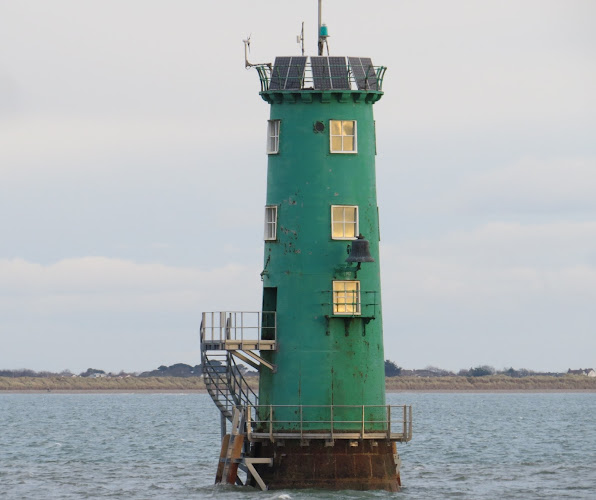The North Bull lighthouse
This is the North Bull lighthouse at the end of the North Bull wall, one of three 'North' lighthouses operated by Dublin port. The North Bank is the square one on stilts in mid-channel and the North Wall Quay light is the black and white one at the end of the quay near the Point or the O2. After many years, I still have to stop and think which is which.
The North Bull in its greenness, warns ships entering or leaving the port to keep between it and the red Poolbeg lighthouse at the end of the South Wall. Poolbeg is famouser because you can walk along the South Wall to the lighthouse. And its longer and older. With the North Bull, you can only get halfway along its 2.7kms before Our Lady, Star of the Sea, tells you not to venture further, as the path ends and the causeway becomes ragged rocks submerged at half tide.
The North Wall was built between 1819 and 1824 and was marked by an unimpressive perch. This perch was regularly blown down, hence this notice from the Irish Examiner 25th March 1867.
This is a painting called The Crew of the American ship, Edward, landing on the North Bull, November 1825. You'd think the artist would have gone down to lend a hand, rather than continue painting. Anyhow, I have half a mind (let me finish) that that is a perch sticking up at the end of the wall, probably about to get washed away yet again
Evidently they decided ten years later that an egg was an egg, because work commenced on building the lighthouse at the end of the North Bull. The March 1st 1878 edition of the Irish Builder reported that
If anybody is interested the Diving Bell, which is a serious piece of equipment, can be found just 100 yards downriver from the Ferryman pub on Sir John Rogerson's Quay in Dublin. God knows what the floating shears were. I have an image of green inflatable hammers from Italia 90.
The following March (1879), the same paper reported that the light was nearly ready.
This is the light as it looks now. Frustratingly I haven't been able to find a photo of the light when it had a lantern and a dome. These days the light, like many others is exhibited from the top of a short pole and is lit by solar panels. The picture at the top of the page shows this better The entrance door, like the round towers of old, is up a flight of metal steps and there is also a fogbell, which is now, I suspect, ornamental. The light pattern is for a green light to flash seven seconds on, one second off.
At one time, the North Bull lighthouse was red and Poolbeg black as per the colouring conventions of the time, but, since the 1940s, green and red are the new red and black.
Since its inception, the North Bull appears to have been a two-keeper light but the only two keepers I have come across were John Francis Garrett and Henry Roche. It is difficult, with the paucity of records available from the Dublin Port Authority to establish which keepers served where. The birth certificates of the children generally give the shore address, rather than the lighthouse name, with the exception of John Garrett's eldest, Edward, who was born at Poolbeg lighthouse in 1881.
John Francis Garrett was a Galway native (possibly the Aran Islands) born around 1853. His father was a coastguard and John's brothers, Henry Garrett and Benjamin Garrett were also lightkeepers in Dublin. John is listed as a lightkeeper on all of his children's birth certs between 1881 and 1900. Then suddenly, on the 1901 Census, he becomes Inspector of Dredging. On the 1911 census, he is actually recorded as being on the North Bull as senior keeper. Married twice, he was pensioned in 1921 and died at Nottingham St, off North Strand in 1939, allegedly aged 80.
Henry Roche was a few years older than John. He had joined the Dublin Port Authority as a seaman in 1871. In 1877, he was a sailor though in 1879, remarkably, he was 'Inspector of Police.' He was back as a sailor in 1890 and then a labourer for the rest of the 1890s. Finally, by 1901 he found his true vocation as a lightkeeper. On the 1911 Census, he was John Garrett's 'servant' at the North Bull. He died in 1927, also aged 80.
Henry Roche, standing with the cap. I wouldn't buy an ice-cream from the feller sitting on the right hand side. Both Henry and John had departed when demanning occurred on the 15th September 1931.
This article seems to suggest that the keepers were resident in the lighthouse for two weeks at a time, rather than travelling back and forth on a daily basis, as I had imagined.









.png)




Interesting as always Pete...the robot lighthouse...early AI perhaps 🤔 😉 Andrew
ReplyDeleteWell Peter Great article I spent many a day fishing on the wall always wondering about the lighthouses thanks.
ReplyDelete